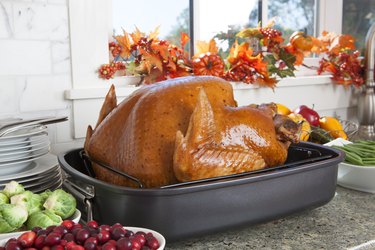
Using a Rival roaster oven frees up space in your oven for other dishes or makes it possible to cook meat in locations without an oven. These small appliances are relatively easy to use, but they have some quirks that you should know to make cooking a success. Always check the Rival appliances manuals for your specific roaster oven model, as some slight differences may exist in how things work and the safety precautions you need to take.
Preparing the Rival Roaster Oven
Video of the Day
If it's your first time breaking out your roaster oven, take the time to carefully unwrap each of the parts and remove any packaging designed to protect the roaster in transit. It's a good idea to wash all removable, washable parts in warm, soapy water before the first use. Depending on the model you have, this might include roasting pans, roasting racks, serving dishes, buffet servers and the lid.
You may also need to assemble your lid before the first use. To do this, you'll need to first remove the screws from the handle. Then, line up the handle with the holes in the lid, and screw both ends of the handle securely to the lid without over-tightening it.
Placing Food in the Roaster
Rival roaster ovens typically come with removable roasting pans. You should always put the food in that pan instead of putting it directly in the body of the roaster oven. Put the removable pan in first, and then load it with the food to avoid spills.
The temperature control on the roaster oven lets you easily get the correct temperature based on what you're cooking. After you rotate the knob to the desired temperature, preheat the roaster 15 to 20 minutes. If you're using the removable roasting rack, position it inside the roaster pan. Then you're ready to add all of the ingredients for your recipe.
Roasting Your Food
Your food cooks best when you leave the lid in place. Each time you open the lid, it lets out the steam and heat, which means you may have to cook the food a lot longer than normal.
Warning
When you do take off the lid, watch for the steam vents and be careful of escaping steam when you open it to avoid burns.
The required cooking time varies widely depending on what you're cooking, the size of what you're cooking and the desired doneness. Use a meat thermometer to check the doneness of any beef, pork, lamb or poultry you cook in the roaster oven. Meat tends to cook faster in a Rival roaster oven than it would in a conventional oven, so check the meat sooner and more frequently to avoid overcooking it.
Meats will develop a crispy, brown crust if you lower the temperature and extend the cooking time in the roaster oven. If you're cooking poultry with the skin on, you can increase the crispiness by using butter or oil to baste it. Roast the poultry with no additional liquids in the roaster until the last 30 minutes.
Baking in the Oven
You can use some models of Rival roaster ovens to prepare baked goods. Just like roasting meats, the Rival roaster's directions for baking require you to preheat the oven. Metal pans work best for baking in a roaster oven because they help brown the food and conduct heat better. Insert the roasting rack into the roaster and put the pan on that instead of putting the pans directly into the roasting pan.
Cleaning the Roaster
Before you clean the roaster, always let the roaster and all of its components cool before you clean it. Empty any remaining food and juices from the roasting pan. Wash all of the removable parts, including the roasting pan, roasting rack, lid and buffet serving pieces, in hot soapy water using a soft sponge or cloth. Don't put the pieces in the dishwasher.
Unplug the oven before cleaning the body. Wipe the exterior and interior of the roaster oven body with a damp, clean cloth. Never submerge the body in water.
Check out this related video from ExpertVillage on Youtube